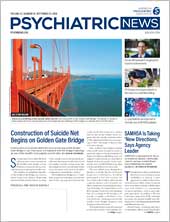Seventy-nine years after the first call to action to erect a barrier on the Golden Gate Bridge in San Francisco, construction on a suicide deterrent is at long last under way.
The number of completed suicides at the Golden Gate Bridge has risen to about 35 per year, about a 30 percent increase in the past decade or so, along with a similar rise in the national suicide rate. Psychiatrists and relatives of the bridge’s suicide victims hope the movement to erect suicide deterrents at key locations will catch on in other communities around the country.
The Golden Gate Bridge is a 1.7-mile long suspension bridge considered one of the top engineering marvels in the world. But it also has a darker side as one of the world’s most frequent sites for suicide, with more than 1,700 confirmed deaths since its opening in 1937. The hope is that all this will soon change.
Now, workers have begun closing some traffic lanes at night to truck in materials and over the next month will begin installing scaffolding that will support construction of a net that is forged of marine-grade woven steel, nearly seven football fields long, that will jut out 20 feet over the water.
The net will be gray, designed to blend in with the fog for which San Francisco is well known. It will be positioned a full two stories—20 feet—below the bridge’s sidewalk and roadway surface so it will not be visible to motorists or pedestrians crossing the bridge. It is hoped that it will deter people from not only jumping but also coming to the bridge with suicide in mind, said Paolo Cosulich-Schwartz, spokesperson for the Golden Gate Bridge Highway and Transportation District.
The Golden Gate’s system is expected to cost $211 million, with funding cobbled together from local, state, and national government sources as well as donations from the public. Paul Muller, president of the Bridge Rail Foundation, which works to prevent suicide from bridges and other public structures, said he has gotten dozens of emails and calls from other communities interested in installing similar nets, and some want to use the Golden Gate project as a gauge of potential costs.
“That’s not appropriate at all,” he said. Construction costs are typically higher in the Bay Area, and this project also includes four new permanent, movable scaffolds and other upgrades, such as a wind-resistance system, that other bridges would probably not need.
The Golden Gate system was modeled after similar suicide-deterrent nets erected at a medieval castle in Bern, Switzerland, and over five of the bridges that crisscross the Cornell University campus in Ithaca, N.Y. The Golden Gate net will be the largest of its kind, however. Such nets have been very successful in deterring suicide at those sites, Cosulich-Schwartz said.
The steel nets are meant to dash the illusion of a peaceful drop into the water, “not to provide a soft, cushy landing for would-be jumpers,” Cousulich-Schwartz said. “We’re trying to make the act of suicide harder and less appealing.” Jumpers are highly likely to break bones—or be rendered immobile—after hitting the steel net.
“This barrier will save many lives,” said Mel Blaustein, M.D., who has led the Northern California Psychiatric Society’s task force to get a suicide barrier erected since 2004. “You will look down and see a 20-foot drop, a pretty painful drop. That’s a remarkable deterrent.” People who are suicidal want to escape pain or avoid pain, he said. Witnesses have seen people run across the traffic on the bridge to avoid getting hit by a car—only to leap over the rail and jump, he explained.
Blaustein, who is director of psychiatry at nearby St. Francis Memorial Hospital, frequently treats patients who have been hospitalized after being removed from the bridge. “A couple of days later, they say ‘What was I thinking?’ Once deterred, the impulse is over.”
He has also interviewed three people who have survived a suicide jump off the bridge. “As soon as they were in freefall, they all said they were thinking, ‘Oh no, what am I doing? I wish I wasn’t doing this. I wish I could live. Please, God, somebody save me.’ ”
When people decide to die by suicide, they use the method with which they are most comfortable, Blaustein added. “If you take away their preferred method, they don’t go somewhere else.” A 1978 study of 515 people who attempted suicide from the Golden Gate Bridge but were restrained from doing so found that 90 percent of them did not go on to die by suicide or by other violent means. Other studies have reported similar findings.
With decades of attempts to get a barrier erected, how did it finally get funded and approved? Bay Area psychiatrists and mental health professionals for years presented decision makers with information about “the nature of suicide and the research showing the benefit of restricting access to lethal means,” Muller said.
Another key to the ultimate success of the campaign was the powerful testimony from the Bridge Rail Foundation’s survivors group—those who had lost loved ones to the bridge. “They brought the needed intensity and passion,” he said.
The Golden Gate’s system is expected to be completed by January 2021. ■
More information about the Bridge Rail Foundation’s work can be accessed
here.

